
Apple’s Siri already has over 86 million users in the US, and that is just one platform. Add Alexa, Google Assistant, and global users, and it is clear: Voice search optimisation is not optional anymore.
In this article, we will explore why now is the right time to adapt and position your content to rank for voice search queries. You will also find smart, straightforward tactics you can put into action, plus the traps to steer clear of along the way.
By the end of your read, you will be ready to create content that ranks high in today’s search engine world.
Future-Proof Your Content: The Real Value Of Voice Search Optimisation
Jot down what stands out. Then, use these points to spark a team discussion about spending more resources on voice search SEO and staying ahead of changing search habits.
A. Drives Inclusivity & Expands Your Audience
Voice search users often include people with speech preferences, visual impairments, or disabilities who rely on smart speakers to access information hands-free. So, when you optimise for voice, you make your content usable in real-life moments.
You future-proof by designing for environments beyond screens, where search happens by voice, on demand, and often when attention is limited.
B. Local Business Advantage In A “Near Me” World
People use voice to find nearby services they need now. They want quick answers, not a list to scroll through. That is when clear answers and sharp local SEO decide who gets the call. If your content answers those “near me” queries with simple, location-rich language, you show up when it matters most.
Suppose you have a local service-based business, like this residential window-washing service in Chicago. When someone says, “Who does window washing near me?”, they are waiting for voice search results to give one clear answer.
If your site does not mention terms like “window washing in Lincoln Park” or answer real questions like “Can someone clean my windows this weekend near Lincoln Park?” your business will not show up.
But if you include those phrases, list your service areas, and keep your Google Business Profile updated, you increase your chances of being the result they hear for local searches and the business they book.
C. Sparks’ Ideas For New Content
When you study how people speak to a voice assistant, you spot the exact questions they actually ask, not just what they type. These spoken phrases often reveal gaps you or your competitors miss.
For example, if you run a gym, these are questions you may overlook:
- What’s the best time to book a personal trainer?
- Can I freeze my gym membership during vacation?
Use those real questions to guide your next blog, service page, or FAQ. These insights do not just improve your content; they shape it around intent. This is how long-tail keywords from voice search lead to smarter content ideas.
Now, who can help you achieve all those benefits?
Delivered Social can audit your website and strategise how to make your content voice-friendly, clear, and easy to find. From identifying real search intent to sharpening your local SEO, you can have your content show up exactly when people are asking.
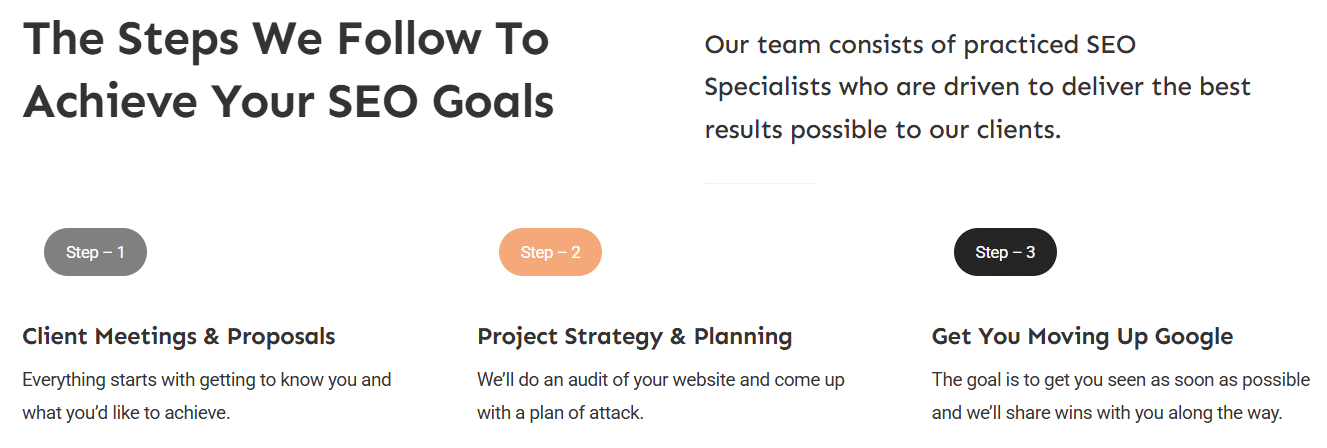
To make this even stronger, work with a branding specialist who can communicate with Delivered Social about your tone, message, and audience. That way, your content sounds like you.
Together, they make sure every voice search result reflects your brand clearly and consistently. It is how you stay recognisable, trustworthy, and easy to choose.
Win The Mic: Voice Search Tactics To Keep Your Content Relevant
Use the tactics here to support your strategy and strengthen your website for voice search. Start small, test what works, and build content that answers how people speak.
1. Master Conversational Keywords
Conversational keywords are the natural, question-based phrases people actually say. They reflect how voice searchers speak, not how they type.
Using these keywords in your content helps you match real search terms people ask their devices. With this, it becomes more than just about ranking; it is now about becoming the answer.
When you show up for full questions, not just fragments, you increase your chances of being featured in Google Search and voice assistant responses. It is a smarter, more human-first SEO strategy.
What To Do
Let’s start with an example. Suppose you are in the sports equipment niche selling these types of golf cart accessories.
Start with the simplest and most accessible tool, Google Search’s “People also ask” section. Type your primary keyword, like “golf cart accessories”, to get results like this:
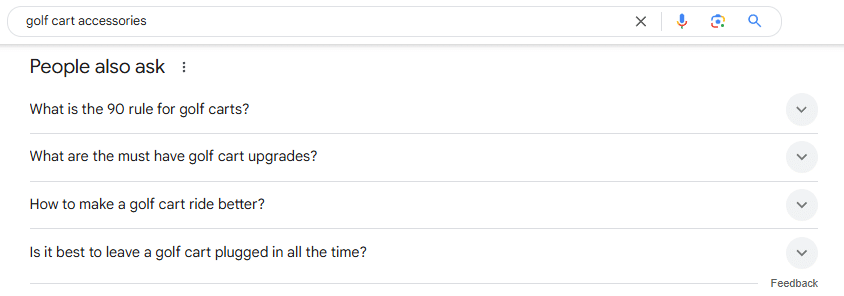
Then, use tools like Ahrefs. Go to “Keywords Explorer,” enter your primary keyword, and scroll to this section:
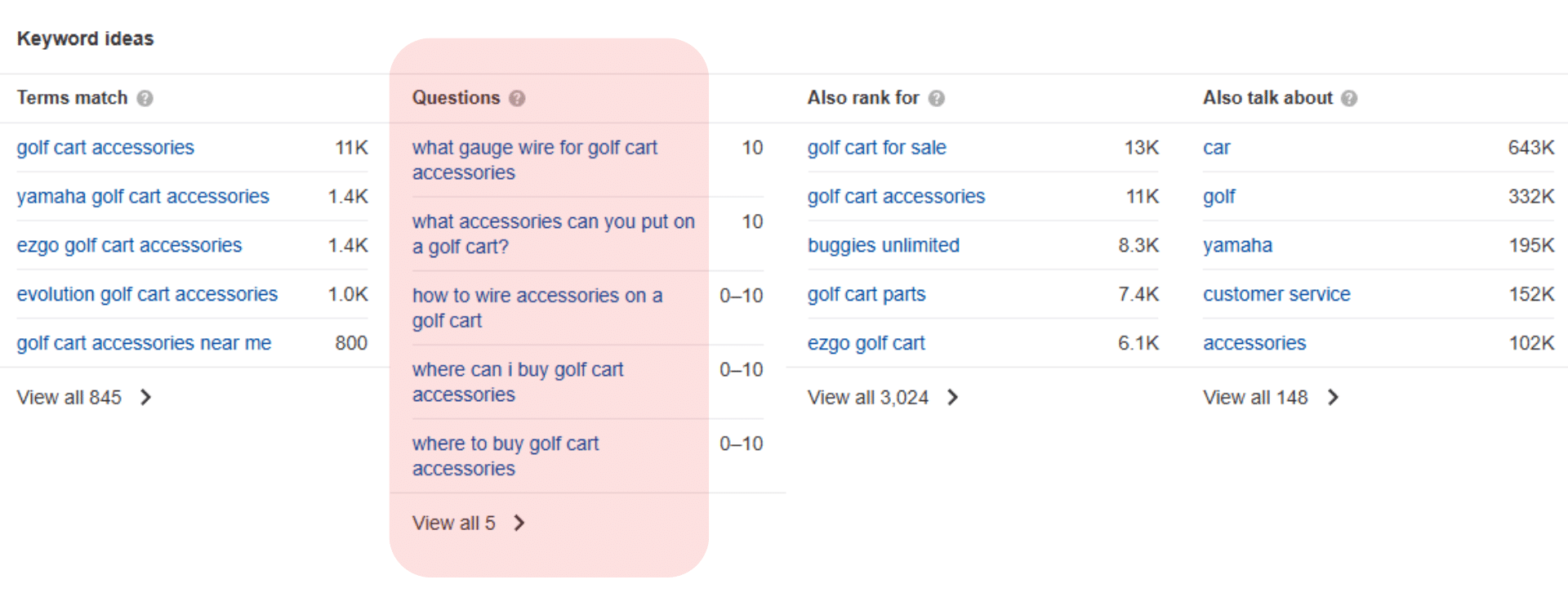
Make sure to choose “View all” under “Questions” because that is where you will find long-tail voice search keywords.
Lastly, you can check Answer The Public to find relevant questions like these:
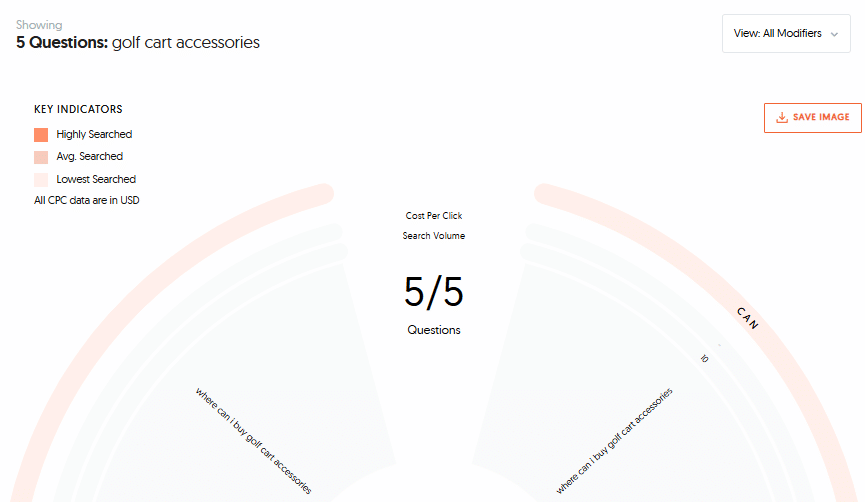
Once you use those tools, write down every question you find. Then, spot the ones that pop up again and again, and make those your priority. Answer them clearly and upfront in your content.
To help you with this, use content planning tools to group similar voice search keywords, map them to specific pages, and plan content around them so each answer fits naturally into your site. This keeps your strategy organised and guarantees nothing valuable slips through the cracks.
2. Create Location-Specific Pages To Capture Local Intent
Location-specific pages are standalone pages on your site, like your homepage or service area pages, tailored to one city, neighbourhood, or region. They help your website content speak directly to local customers, not just a general audience.
Here’s an example from a Sydney-based property agency:

These pages play a big role in capturing voice search traffic. Why?
Because most people do not just say “real estate,” they ask things like “real estate agents near me” or “best real estate agency in Sydney’s Inner West.” If your site does not reflect those local voice search queries, voice commands will not pick you up. You need content that matches how people ask: Spoken, specific, and local.
What To Do
To create location pages effectively, follow these:
- Include customer reviews from that location.
- Include contact info and maps tied to that exact area.
- Use local keywords naturally in headers and body text.
- Mention landmarks, zip codes, or service areas your customers recognise.
- Mention your participation in local events to build trust and local relevance.
- Break down your service areas (e.g., Newtown, Surry Hills, Parramatta) to match hyperlocal voice commands.
- Add voice-friendly subheadings that match local questions like “How much does a home cost in Bondi?” or “Where to find top agents in Sydney CBD?”
3. Create & Optimise Your Google Business Profile
Your Google Business Profile is your official listing in Google Maps and search results to help people see key company info at a glance.
Here’s what it looks like when you search Delivered Social:
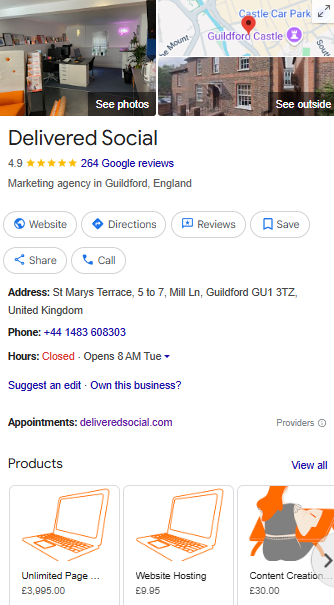
Why does this matter for voice search optimisation?
Because many voice searches ask for specific business details like hours, directions, or services. If your profile is incomplete, Google cannot provide direct answers, which means you miss out on leads.
Meanwhile, a complete listing increases your chances of showing up when people use voice search, especially for ready-to-act queries. It can also improve your overall search engine rankings without needing extra content.
What To Do
Follow these steps to create your Google Business Profile:
- Go to google.com/business.
- Click “Manage now.”
- Enter your business name and click “Next.”
- Choose your business category (e.g., café, accountant, plumber).
- Add your physical location if you serve customers at a storefront.
- Enter your service area if you deliver or offer off-site services.
- Add your business phone number and website URL.
- Choose a method to verify your business.
- Once verified, add your services, business hours, company description, photos, and FAQs.
Make sure to keep your info fresh. If anything changes in your business, like hours, services, or contact details, update it right away so it stays accurate and lines up perfectly with your website.
4. Write How You Talk To Win Voice-First Results
Shaping your homepage or any web page like you are having a real conversation, not giving a lecture. It helps voice assistants find and read your content more easily when people ask everyday questions.
In addition, voice assistants rely on natural language processing, which favours content that sounds human. Meanwhile, if your writing feels stiff, robotic, or overloaded with jargon, it will not match what people actually say.
The results?
Your website will not show up when someone asks a voice search device for help. You need to sound like the answer, not an instruction manual.
What To Do
Write effectively uses these rules:
- Use short sentences that get to the point.
- Use words like “you,” “your,” and “we” to keep it personal.
- Break up big blocks of text with subheadings and line spacing.
- Avoid buzzwords and industry speak. Say it like your customer would.
- Use verbs over nouns to keep your tone active. Say “increase sales” instead of “sales growth” to keep things direct.
- Cut filler words that do not add value. Words like “in order to” or “utilise” slow the message; just say “to” or “use.”
- Write the way you would explain it to a customer face-to-face. If you will not say it out loud in conversation, do not write it that way.
This article about classroom poll makers is a great example to follow:
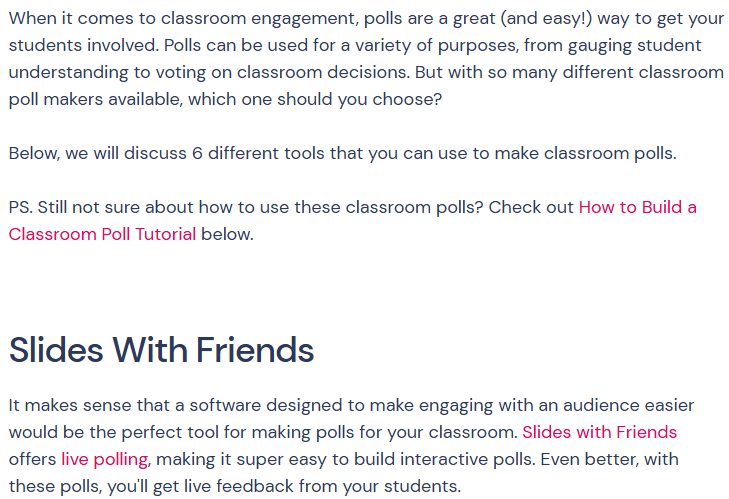
Even though the article covers software, it stays clear, natural, and easy to follow. It uses short sentences, a friendly tone, and speaks directly to the reader. Plus, the structure is clean, the language sounds like real conversation, and it gets to the point.
That way, when someone asks, “What’s an easy classroom poll maker for teachers?” Google is more likely to pull a voice search result directly from this article.
5. Create Content Based On Real-World Scenarios
Write for moments your customers actually face on your homepage, blog, or service pages. Think of daily situations, not abstract ideas.
This approach works because people use voice search in real time. They do not ask “benefits of pest control services,” they say, “What do I do if there are ants in my kitchen?”
Voice search technology listens for content that sounds helpful, not scripted. If your answer fits the moment someone’s in, it can turn into clicks, calls, and real conversions.
What To Do
To create content based on real-world scenarios, do these:
- Turn everyday problems into how-to guides.
- Use customer questions you hear on calls or in chats.
- Include time-based triggers like “before winter” or “right after moving.”
- Use location-specific issues that reflect your audience’s environment.
- Think about when and why people need your service, not just what it is.
6. Format Content Clearly To Win Featured Snippets
A featured snippet is the short box of text Google shows at the very top of the search engine results pages (SERPs). It is the answer users see (or hear) before anything else. Featured snippets receive 35.1% of all clicks, which means they directly impact your traffic.
Here’s an example:
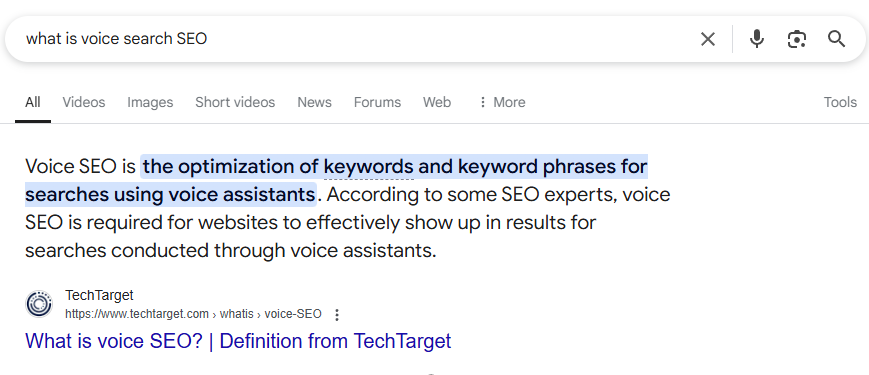
For Google Voice search, it is not just about being helpful; it is about being the fastest to deliver the right info. Google Home doesn’t scroll or compare options; it grabs the cleanest, most direct result.
If your content does not stand out clearly, it gets skipped. You need to structure answers so Google can lift them instantly and trust that they will sound good when spoken.
What To Do
Use real questions as your subheadings—think “What is…” or “How do I…”. Then, follow each question with a 40–50-word concise answer. If you are doing step-by-step instructions, do bullet points or numbered lists, like this:
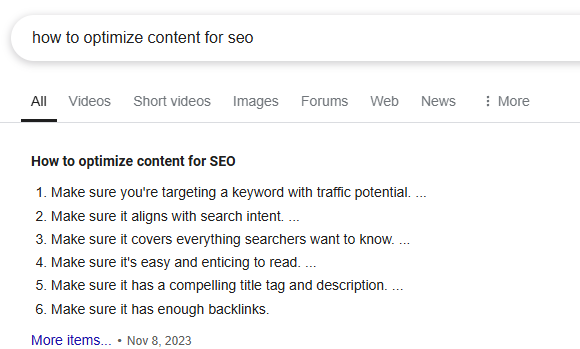
Additionally, put key answers near the top of your page, not buried halfway down. For example, let’s say you run an SEO agency and you are writing an article or an FAQ page about SEO audits. Do not wait to answer “What’s included in an SEO audit?” Put it right at the top so Google can find it instantly.
7. Zoom In On User Intent To Shape Smarter Content
User intent is the real reason behind a search. What someone wants to find, learn, or do when they type (or say) a query.
Most voice queries come from people who want practical answers, not just keyword-matching content. If your page does not match their intent, they will leave fast.
But if you zoom in on intent, you create content that meets people exactly where they are in the sales funnel. This is how you stop attracting the wrong clicks and start showing up for the exact questions your ideal customers ask. With that, you can improve your voice search rankings and earn trust fast.
What To Do
Identify whether the user intent is informational, navigational, commercial, or transactional.
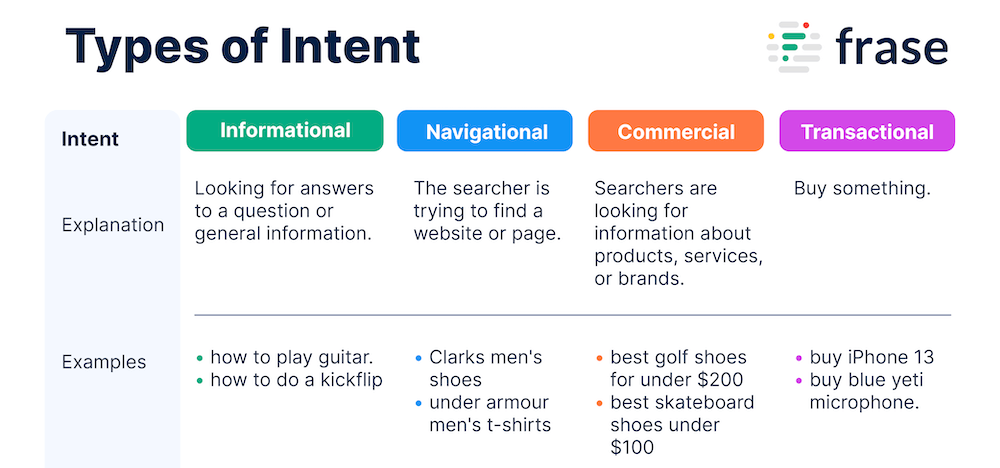
You should also check the top-ranking pages for your keyword and see what intent they match. Say your target keyword is “SEO audit checklist.” Check the top-ranking pages:
- Are they guides for beginners or detailed technical templates?
If most pages explain the basics, writing a highly advanced checklist may miss the mark. It is better to match the intent first and then bring something better to the table.
Lastly, apply semantic SEO to focus on meaning that supports intent, not just keywords. Here’s an example: If you are writing an article on an “SEO audit checklist,” do not just list steps.
Cover related topics like “why audits matter,” “tools to use,” and “how to prioritise fixes.” That is semantic SEO. You build depth by covering connected ideas so Google understands the full meaning and matches it with real intent.
Voice Search Optimisation Traps That Can Hurt Your Rankings
Use this section to clean up weak spots in your content. Simple fixes can keep you ahead as the voice search revolution changes how people discover businesses like yours.
I. Not Optimising For Mobile
Most voice queries happen on mobile devices, not desktops. So if your site ranks well on computers but not on phones, you miss where most searches begin.
Voice search prioritises content that performs smoothly on the go, and that means being truly mobile-friendly. Think about it: mobile users are not in research mode like they are during the traditional search.
And voice search doesn’t stop at smartphones. Smart TVs, kitchen hubs, and voice remotes are all part of the ecosystem now. With 1 in 6 Americans now 65 or older, many in this group turn to smart home devices because they are easier to navigate than phones or computers. So if you are not optimized for these devices, people will bounce before you get their attention.
Here’s how to keep your site mobile-friendly and voice-ready:
- Avoid pop-ups that block the screen.
- Test page speed and compress images.
- Make buttons large and easy to tap for mobile searches.
- Use a responsive design that adjusts to all screen sizes.
- Cut long blocks of text. Use short paragraphs and headings.
II. Forgetting To Optimise Contact Information Pages
When someone asks a voice assistant for a phone number, directions, or business hours, digital voice assistants often pull from your contact page. If that page is not clear or well-structured, Google can skip it.
So you may have the best service in town, but if your contact info is not voice-ready, someone else with a cleaner setup will grab that average voice search result spot.
Here’s an example you can take inspiration from:

Delivered Social also has direction pages like this:
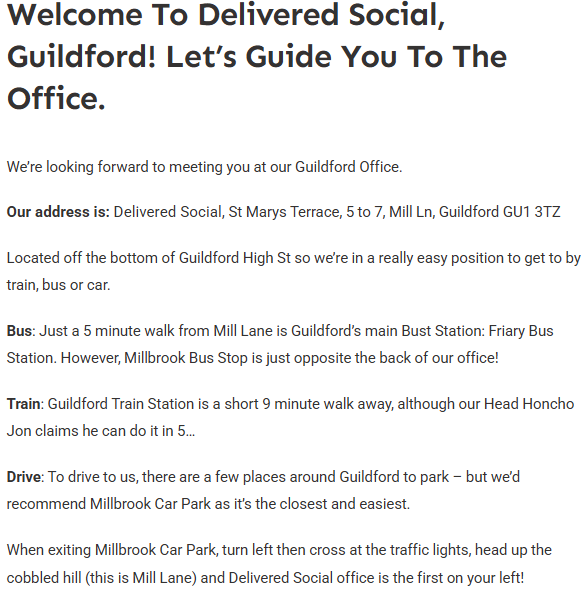
Here’s how to make sure your contact page pulls its weight:
- Embed a clickable map for easy navigation.
- Add opening and closing hours in text (not just images).
- Match the info with your Google Business Profile exactly.
- Include voice-friendly FAQs like “Are you open on weekends?”
- List your full business name, address, and phone number at the top.
III. Ignoring Prepositions In Search Phrases
Ignoring prepositions in search phrases might seem small, but it is a big miss in voice search optimisation. Prepositions like in, for, with, and near add clarity and context when someone uses a voice search option on their phone or speaker.
If you leave them out, your content sounds unnatural to smart devices, and it will match how people speak. That mismatch can drop you from different search engines’ voice results, even if your info is accurate.
- Use “People Also Ask” for clues because it is full of search phrases with natural prepositions—copy those patterns.
- Avoid over-simplified keyword stuffing. Stripping out prepositions for “clean” SEO weakens voice relevance and sounds robotic to different search engines.
- Review voice recordings or transcripts (from support calls, chatbots, etc.) to see how people phrase questions out loud.
- Use full expressions like “best cafes in Melbourne” instead of shortening to “best cafes Melbourne.”
Conclusion
Segment your content into quick wins and long-term fixes. For example, you can start with your high-traffic pages, like FAQs, contact information, product pages, and service descriptions, and shape them for voice search optimisation.
Look at user behaviour and choose one area where voice can remove friction. To help you with that, partner with Delivered Social. Our SEO experts can audit your site to identify the best pages to anchor your voice search strategy. Reach out now and let’s start planning.
Interested In Working Together?
Introducing Delivered Social. We’re The Most-Rated Digital Agency In Surrey & Hampshire – We’ve Got To Be Doing Something Right.
Delivered Social is a digital marketing agency with one mission—to help businesses grow. We’re famous in Guildford and Portsmouth for our social clinics. We believe in free advice. We build lasting relationships because our team prides itself on being helpful, which our clients appreciate.
If you are looking for a new website or an agency to manage your social media presence, we can help.
If you need something slightly different, here's a super handy list of all our services, or you can always email us.


















